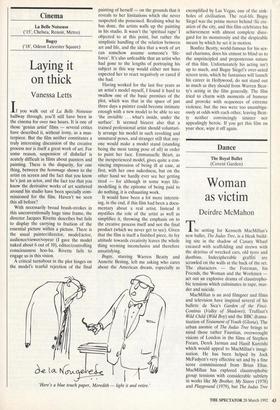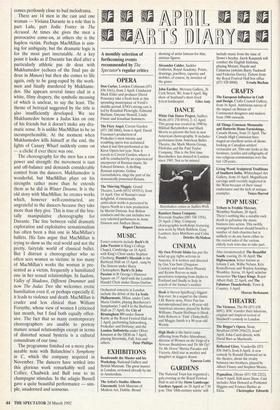Dance
The Royal Ballet (Covent Garden)
Woman as victim
Deirdre McMahon
The setting for Kenneth MacMillan's new ballet, The Judas Tree, is a bleak build- ing site in the shadow of Canary Wharf encased with scaffolding and strewn with the detritus of wrecked cars, old tyres and dustbins. Indecipherable graffiti are scrawled on the walls at the back of the set. The characters — the Foreman, his Friends, the Woman and the Workmen — act out an explosive drama of claustropho- bic tensions which culminates in rape, mur- der and suicide.
MacMillan is an avid filmgoer and films and television have inspired several of his ballets: de Sica's Garden of the Finzi- Continis (Valley of Shadows); Truffaut's Wild Child (Wild Boy) and the BBC drama- tisation of Testament of Youth (Gloria). The urban anomie of The Judas Tree brings to mind those rather Faustian, overwrought visions of London in the films of Stephen Frears, Derek Jarman and Hanif Kureishi which would appeal to MacMillan's imagi- nation. He has been helped by Jock McFadyen's very effective set and by a fine score commissioned from Brian Elias. MacMillan has explored claustrophobic group tensions with considerable subtlety in works like My Brother, My Sisters (1978) and Playground (1979), but The Judas Tree
comes perilously close to bad melodrama.
There are 14 men in the cast and one woman — Viviana Durante in a role that is part Lulu, part Jodie Foster in The Accused. At times she gives the men a provocative come-on, at others she is the hapless victim. Perhaps MacMillan is aim- ing for ambiguity, but the dramatic logic is for the most part inscrutable. At a key point it looks as if Durante has died after a particularly athletic pas de deux with Mukhamedov (echoes of the final pas de deux in Manon) but then she comes to life again, only to be gang-raped by the work- men and finally murdered by Mukhame- dov. She appears several times clad in a white, filmy drapery, the symbolic meaning of which is unclear, to say the least. The theme of betrayal suggested by the title is also insufficiently developed. We see Mukhamedov bestow a Judas kiss on one of his friends but it doesn't make any dra- matic sense. It is unlike MacMillan to be so incomprehensible. At the moment when Mukhamedov kills himself at the end, the lights of Canary Wharf suddenly come on — a cliché if ever there was one.
The choreography for the men has a raw power and strength: the movement is taut and off-balance and demands considerable control from the dancers. Mukhamedov is wonderful, but MacMillan plays on his strengths rather more than he extends them as he did in Winter Dreams. It is the old story with MacMillan: he creates works which, however well-constructed, are ungrateful to the dancers because they take more than they give. This is true of the bru- tally manipulative choreography for Durante. The line between valid dramatic exploration and exploitative sensationalism has often been a thin one in MacMillan's ballets. His fans argue that MacMillan is trying to show us the real world and not the pretty, fairytale world of classical ballet. But I distrust a choreographer who so often sees women as victims: in too many of MacMillan's works the woman is pre- sented as a victim, frequently a humiliated one in her sexual relationships. In Isadora, Valley of Shadows, Different Drummer and now The Judas Tree she welcomes erotic humiliation even if, or perhaps especially if, it leads to violence and death. MacMillan is cruder and less clinical than William Forsythe, whose view of women I criticised last month, but I find both equally offen- sive. The fact that so many contemporary choreographers are unable to portray mature sexual relationships except in terms of distorted sexual hysteria is a cultural conundrum of our time.
The programme finished on a more plea- . surable note with Balanchine's Symphony in C, which the company acquired in November. The dancers have settled into this glorious work remarkably well and Collier, Chadwick and Bull rose to its champagne stimulus. In the adagio Busse11 gave a quite beautiful performance — sim- ple, unadorned and sensuous.



























































 Previous page
Previous page